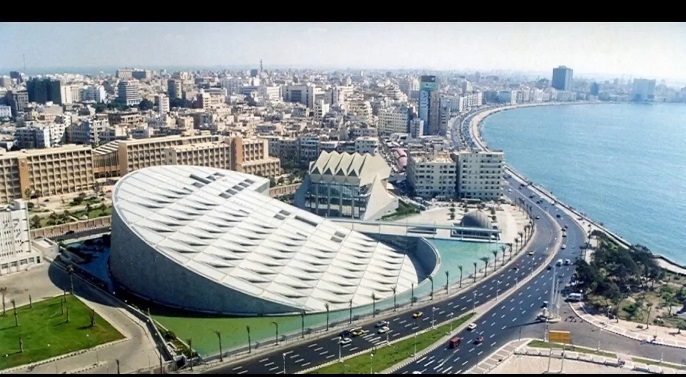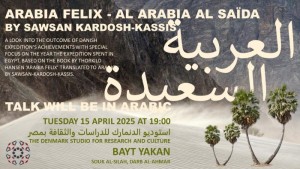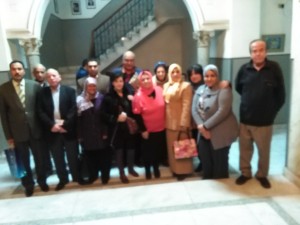Alexandria, the main harbor of Egypt on the Mediterranean, was once called "The pearl of the Mediterranean". Strabo, the geographer in the 1st century AD, called Alexandria "The greatest emporium of the inhabited world". The city was supposed to witness the inauguration of its re-built famous library, "Bibliotheca Alexandrina" on 23 April 2002, a date that was postponed due to the ongoing political strains in the Middle East. The word "bibliotheca" comes from the Greek word for "books", since the ancient library belonged to the Hellenistic period.
Alexander the Great built the city in 331 BC, and upon his death his widespread empire was divided among several rulers. Ptolemy, one of his generals, chose Egypt and started a new royal house. Alexandria became the capital of the state, and by the year 200 B.C., it grew into the largest metropolis in the world, and became the world's scientific and intellectual Mecca.
The legacy of the Ptolemies was highlighted by major achievements, notably its university, the Great Library, the lighthouse that was considered among the Seven Wonders of the World, as well as the "Temple of Serapis" and the "Heptastadion" that connected the Island of Pharos with Alexandria. Although ancient Egypt had known papyrus libraries as far as 3200 B.C., and Athens had a great library in the 4th century B.C., the "Bibliotheca Alexandrina" was the largest in all antiquity. It was also a part of a research institute, known as the "Alexandrian Museum" or "Mouseion" - a word related to the shrine of the "Muses" which was a customary feature of the Greek schools that attributed philosophic and artistic inspiration to the Muses and science.
THE ANCIENT LIBRARY
The Mouseion was built in the district known as "Brucheium" within the vicinity of the royal palace. Strabo described it as a large complex of buildings and gardens with richly decorated lecture and banquet halls linked by colonnaded walks.
"It was part of the royal palaces, it had a walk [peripatos], an arcade [exedera], a large house in which was a refectory for members of the Mouseion. They formed a community who held property in common with a priest appointed by the kings in charge of the Mouseion."
The University and renowned Library were built as part of the Museum in 290 BC by Ptolemy I-Soter, though some sources suggest that it started during the reign of his son, Ptolemy II- Philadelphus. The actual founder was "Demetrius Phalereus", a follower of Aristotle and counselor of Ptolemy I-Soter, who suggested to the king the idea of establishing a great research center with a universal library attached to it. Such a suggestion fitted perfectly with Soter's desire to render Alexandria not only the capital of a powerful kingdom but also a center of culture and civilization. Demetrius remained in charge of the library until Soter's death in 283 BC when he was banished by Philadelphus in retaliation to the former's advice to Soter to pass kingship to another son.
The library was staffed by many famous Greek writers and scholars, and contained a vast collection of books, and over 700,000 scrolls and papyri. It was a tradition that if any book was found in a ship that visited Alexandria. This was taken to the Library to be copied and hence no manuscript was available in any library worldwide and not in Alexandria. Documents were arranged in systematic order in the form of books, as they are now known. Scientists, philosophers and artists from allover the world were invited to study and enrich the university and library, that made Alexandria carry the beacon of civilization until it was burned by the Romans in 48 BC.
During the reign of Ptolemy III-Euergetes, the amount of books acquired exceeded the capacity of the original library, and a subsidiary "Daughter Library" was established about 235 BC in the Temple of Sarapis (Serapeum). The Daughter Library soon developed into a proper one, and in the Roman period it became an active learning center.
The chief Librarian of Alexandria was chosen from the most prominent scholars in science or literature, and was appointed by the king himself. He was described as "who was in charge of the King's Library", "president of the Library" or "bibliophylax" (keeper of archives). Demetrius of Phaleron was the first to hold such elite post.
"Hyperetae" were library assistants who were in charge of registration and classification of the books. This included its source, author's name, and that of the scholar who edited the text. Books were labeled as "symmigeis" (mixed) when they included more than one work, and "amigei" (unmixed) for single texts. The length of the text rated the scribe's fees according to quality of writing and number of lines. Two documents describe the method of payment as
"for 10,000 lines 28 drachmas... for 6,300 lines 13 drachmas" and
"to a scribe for best writing, 100 lines, 20 denarii; to a notary for writing a petition or legal document, 100 lines, 10 denarii."
A record or registry of the contents of the Library was called "Pinakes" (tables), a task that was given to Callimachus the poet, who classified every field of learning according to subject (rhetoric, law, epic, tragedy, comedy, lyric poetry, history, medicine, mathematics, natural science and miscellanea). Under each subject, authors were alphabetically arranged, followed by a short bibliographical notice and a critical account of the author's writing.
SCHOLARS
The chief librarian always had at his disposal a large budget in order to collect all the books in the world, either by purchase or transcription. The number of books exceeded half a million, most of which were Greek. Among that collection were "Aristotle's books", that were later transferred to Rome.
The Library also encouraged translations. The "Septuagint" - which was the first translation of the Old Testament from Hebrew to Greek - took place there during the third and the second centuries BC as a necessity for the large Jewish community in Alexandria.
Among the most famous scholars who studied at the Alexandria Mouseion was the famous mathematician Euclid (300 BC) during the reign of Ptolemy II-Philadelphus. Euclid wrote 13 books on mathematics, particularly geometry called "The Elelments", which provided a comprehensive analysis of geometry, proportions, and theory of numbers, and also had some notable studies in geometrical optics. Archimedes (287-212 BC) discovered the upthrust theory, and invented the pump known as "Archimedes' screw" which is still used today.
Heron (A.D. 62), the Alexandrian mathematician, directed his studies to solving practical problems and equations arithmetically, and found a formula for the area of a triangle. He was also an engineer who applied Archimedes"™ previous principles to invent many devices as siphons and pullies. Heron wrote several books in geometry ("Geometrica", "Stereometrica", and "On Measures"), mechanics, as well as mirrors.
Eratosthenes (275 - 195 BC), the poet, philosopher, astronomer and chief librarian in the 3rd century BC, calculated the Earth diameter - more than 15 centuries before Copernicus and Galileo. Since he believed the Earth was round, and knowing the distance between Alexandria and Aswan, Eratosthenes measured the shadows in both cities on the same day on two successive years. With simple calculations, he estimated the diameter at 7,850 miles, only about 0.5% off today's measure. His co-worker, Aristarchus of Samos, suggested the heliocentric hypothesis, which stated that the Earth and the planets revolve around the Sun. Claudius Ptolemy, in the 2nd century AD, proposed a different theory that stated that the universe revolves around the Earth, and which remained valid until the 16th century. Also in the 2nd century BC, Hypsicles first divided the circle of the zodiac into 360 degrees.
Medical schools were also developed, and the most eminent professor was "Herophilus of Chalcedon", who one of his pupils "“ Callimachus "“ founded his own independent school which rivaled that of his master. Another school founded by "Philinus of Cos" thoroughly studied anatomy, physiology and experimental therapeutics. Later, the best of both schools were combined by "Heracleides of Tarentum", who practiced human anatomy and developed surgical techniques, while maintaining the experimental method of cure.
No doubt that Greeks drew much of their knowledge in medicine from the ancient Egyptians. Though it is believed that Herophilus was the first to mention in his writings "counting of the pulse", Breasted - the father of modern Egyptology - noticed that it was mentioned in the Edwin-Smith Papyrus as early as 1600 B.C. He also suggested that Herophilus might have used for this purpose a "clepsydra" "“ an instrument which existed since the time of Thotmose III (1458 "“ 1415 BC). As the first treatise on the head of the Ebers Papyrus (3000 B.C.) is entitled "Beginning of the secret of the physician", some authors suggest that counting the pulse was one of the secret teachings which the Egyptians did not communicate with the Greeks.
In the 2nd century A.D., Alexandria's reputation in the study of medicine attracted Galen, the last of the great physicians of the ancient world and affected much his studies. In the 4th century A.D., "Marcellinus" the eminent historian wrote "medicine continues to grow greater from day to day, so that a doctor who wishes to establish his standing in the profession can dispense with the need for any proof of it by saying that he was trained at Alexandria".
The Museum also included famous poets and philosophers, as Philitas (330 BC), the tutor of Ptolemy II, who was much concerned with the collection and interpretation (glossae) of rare poetic words. His pupil Zenodotus of Ephesus (325 BC) made the first critical edition of Homer and other poets.
The great poet Callimachus (305 BC) compiled the "Pinakes" (Tablets), a vast catalogue of the chief authors and national bibliography, which remained as a standard reference work of Greek literature until the Byzantine period. He also wrote a book opposing the chief Peripatetic critic of the time, "Praxiphanes".
Zenodotus' editions were improved by the fourth librarian, Aristophanes of Byzantium (257 BC), who wrote "Lexeis" (Readings) that edited the lyric poets and compiled useful summaries of the plots of plays with details of their productions.
Philosophy in Alexandria flourished only with the expansion of the Roman Empire. Alexandria had its own philosophers as Theodorus the Atheist, Hegasias the Advocate of Suicide, and Antiochus of Ascalon. Religious philosophy also developed among Jews, Christians and more importantly by pagan philosophers.
Many Egyptians came to study at the Mouseion, and many ended by becoming staff members. The most famous of those was Manetho of Sebennytos, an Egyptian monk of the early 3rd century BC, during the reign of Ptolemy I and II. In 250 BC, Manetho compiled a three-volume book, "Aegyptica", in which he divided the dynastic periods of the ancient Egyptian kingdom (after unification by Menes) into thirty dynasties, the first starting in 3150 BC, and the last ending by the Macedonian conquest by Alexander the Great in 332 BC. Manetho also wrote about the "pre-dynastic period" but in a rather mythical fashion, including the time when Egypt was ruled by gods, demigods, the spirits of dead and finally the mortal kings. Unfortunately those books were lost, but parts of their material have reached us through further scholars as the Jewish historian Flavius Josephus in AD 60, and Christian writers as Julius Africanus in AD 300, Eusebius in AD 340, and George Syncellus in AD 800. "Horapollon the philosopher" originally came from Upper Egypt to study in Alexandria, and later became head of the pagan school. His father too had been a professor at Alexandria before him.
Jealousy and rivalry developed between students of ancient Alexandria and those of other schools, particularly Athens. Synesius, Bishop of Cyrene wrote in a letter:
"Athens has no longer anything sublime except the country's famous names ............... Today Egypt has received and cherishes the fruitful wisdom of Hypathia. Athens was aforetime the dwelling-place of the wise; today the bee-keepers alone bring it honor."
THE DESTRUCTION OF THE LIBRARY
During the co-regency of Cleopatra and her brother "Ptolemy XIII", a conflict evolved that was resolved by Julius Caesar upon his arrival at Alexandria in 48 BC. Caesar sided Cleopatra and granted her the throne. Ptolemy in rage accused them both of treason and led the army to siege the palace, in what is known as "The Alexandrian War". Caesar sent for supplies from Rome, but was outnumbered by his enemy's fleet that controlled the harbor. To avoid a naval combat, Caesar burnt 110 Egyptian ships at dockyards that enabled him to occupy Pharos, control the entrance to the harbor and establishing direct communication with his main forces across the sea. The fire extended to the city and the Great Library (Megale Bibliotheke), and a number of 40,000 books (400,000 in some sources) were burnt, with a tremendous loss of treasures and human heritage.
Some modern scholars deny this fact, based on the writings of one of Caesar's officers, the author of "The Alexandrian War". In that book, the author wrote that the buildings of the city had no wood in their construction and were therefore fire-proof, thus negating that the library building could have caught fire. Yet in a later passage, the author contradicted himself when he described how the Alexandrians in their attempt to rebuild their fleet were "short of oars and therefore used the wood of the roofs from porticos, gymnasia and public buildings". Later writings in the 3rd century AD spoke of storehouses of grains and books that were lying on the docks for export and were burnt.
After Caesar's death, Cleopatra allied with Mark Anthony, and in 34 BC they celebrated his successful conquest of his opponent Octavius at the Gymnasium in Alexandria. Anthony gave Cleopatra a new library of 200,000 scrolls as compensation to the original ones.
The buildings of the Museum faced another destruction in AD 270. Zenobia, Queen of Palmyra (a Roman colony, now in Syria), was not content to remain a Roman client. In 269, claiming to be the legitimate heiress and descendant of Cleopatra, she seized Egypt and much of Asia Minor before declaring her independence from Rome two years later. Zenobia was defeated by the Roman emperor Aurelian, and during the siege of her army at the district of Brucheium, the Museum was partly destroyed.
The Daughter Library became the principle one after the burning of the Great Library, and survived for many centuries until the late 3rd century AD. In AD 312, Christianity was announced as the official religion of the Roman Empire and the state support for indigenous cults ceased, while the Alexandrian triad of Gods (Serapis, Isis and Harpocrates) was still prominent. The sanctity of temples began to be threatened, and the library endangered due its location inside the Sarapeum. Civil war grew between Christians and Pagans, and in AD 389, the Temple of Serapis at Canopus fell to the hands of Christians. In AD 391, the Roman Emperor Theodosius prohibited non-Christian religion, and authorized "Theophilus", the fanatic Bishop of Alexandria, to transform the temple of Dionysus into a church. The pagan inhabitants fled to the Sarapeum as a last refuge, but the emperor issued a decree allowing the demolition of all temples in Alexandria. The Bishop and his followers raided the temple and the library and completely destroyed them, turning the complex into a church. Some scholars believe that the reason for burning the Daughter Library was not only in pursue of pagans, but also to end the Alexandrian Church and theological studies and to transfer the center of Christianity to Rome.
Some scholars survived until AD 415, when Hypatia the philosopher and the last scholar who taught at the Mouseion was assassinated. Her body was shattered into pieces and burnt in accusation of teaching Plato's philosophy that was considered heretic. Her death marked the end of Alexandrian school of philosophy.
THE MODERN RE-BUILDING OF THE LIBRARY
The first call to revive the Ancient Library came from Alexandria University, which allocated the land very close to the original location, and established a distinguished Conference Center as part of the whole project. The complex lies in a location facing the sea and close to the modern Alexandria University Complex. Mohsen Zahran, the project manager said " the new library will encourage peace and the exchange of ideas throughout the region and provide a place for scholars of diverse backgrounds to meet."
The Egyptian president adopted the project nationally, and calls were made for international sponsorship from the UNESCO. An organization was founded in 1988 to carry on with that project, and on 25 June 1990, the president laid its first stone. The construction was executed in 1995 by Egyptian, British and Italian companies, with a total cost of US$ 176 million. A "soft opening" took place in October 2001, when the library was experimentally opened to the public for one month.
Designed by a Norwegian architect, the New Bibliotheca Alexandrina takes the shape of a circular diaphragm wall "“ 160 meters in diameter and 33 meters high - representing the sun. It consists of 11 floors with a total area of 85,405 square meters. The whole complex includes two other libraries (Library for the Blind and Young Peoples' Library), a large convention center, planetarium, four museums (science, calligraphy, manuscripts and archeological) as well as the International School of Information Studies, Center for the Preservation of Rare Books and Documents, as well as research center and exhibition areas. The library is planned to contain 8 million books, 4000 periodicals, 50,000 manuscripts and rare books, 50,000 maps as well as audio-visual and multimedia materials and computer data bases.
In the year 2001, a law was issued to render the library an independent body directly affiliated to the President. The "Council of Patrons" includes the Egyptian President, the French President, the Queen of Spain, Director-General of the UNESCO and other international dignitaries. The "Board of Trustees" is chaired by the First Lady, and Dr. Ismail Serag-El-Din was appointed as Director General.




